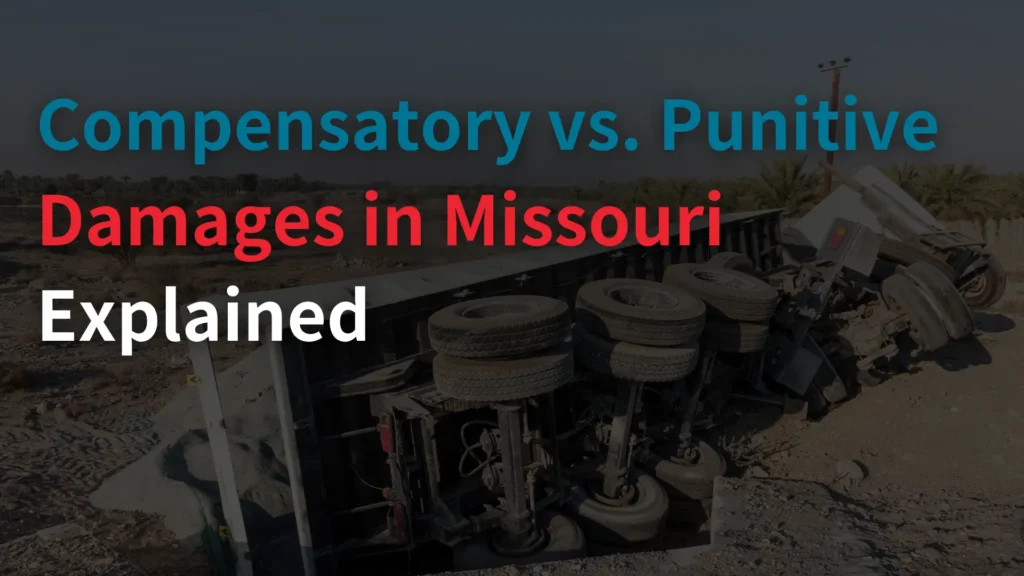
If you got hurt because of someone else’s careless or wrongful actions, knowing the types of damages you can pursue in a lawsuit is crucial. The two main categories are compensatory damages and punitive damages. While both address harm, they have different purposes and are awarded under unique circumstances. Let the St. Louis personal injury lawyers of Goldblatt + Singer break down the difference between these damages, how they are calculated, and what qualifies as punitive damages in Missouri.
Compensatory damages strive to reimburse a victim for the actual harm they have suffered. They aim to make the injured party “whole” again, as closely as possible, by covering losses directly linked to the injury. These damages are commonly divided into two categories:
These are tangible losses with clear monetary values, such as:
Example: Suppose a car accident caused by a distracted driver leads to $50,000 in medical expenses, $10,000 in lost income, and $5,000 in vehicle repairs. In this case, the injured party could claim compensatory damages for those exact amounts.
These account for intangible losses, such as:
Non-economic damages can be trickier to figure out since they do not come with a set dollar value, but that does not make them any less important when it comes to making sure a victim gets what they deserve. Insurance companies and attorneys may use different methods to assess the value of non-economic damages.
One method is the per diem method. In this method, the lawyer or adjuster chooses an amount to represent the value of a single day’s pain and suffering. In many cases, the injured person’s wages for a single day are used for this number. All the days the injured person suffers the effects of the injury are counted and multiplied by the per diem number. That amount is the value of the non-economic losses.
Another method frequently used is the multiplier method. In this method, we calculate the total economic losses and multiply them by a factor ranging from 1.5 to 5. The worse the injuries, the higher the factor. The product of the multiplier and the economic losses is the value of the non-economic portion of the claim.
Punitive damages, on the other hand, are not awarded to compensate the victim. Instead, they are meant to punish the wrongdoer for extremely egregious or malicious behavior and to deter similar conduct in the future. Missouri courts only award punitive damages in cases where the defendant’s actions were willfully reckless, fraudulent, or intentionally harmful.
To qualify for punitive damages in Missouri, plaintiffs must provide evidence that the defendant acted with:
Here is an example of punitive damages: Imagine a company knowingly selling a defective product that ends up seriously hurting people. The court will impose punitive damages to make one thing perfectly clear: reckless, irresponsible behavior has consequences, and they will not get away with it.
Understanding the distinction between compensatory and punitive damages is imperative. It lays the foundation for presenting a strong argument.
Compensatory damages reimburse victims for their harm, whether for measurable economic losses or intangible losses. The goal is to make the injured party “whole” again by covering these losses and helping them move forward after an accident or injury. Compensatory damages are the baseline in most personal injury cases. They are about holding the defendant accountable for the real, tangible ways their actions disrupted the victim’s life.
Punitive damages serve a different purpose. Instead of addressing the victim’s losses, they punish the wrongdoer for outrageous or malicious behavior and send a clear message that this misconduct will not be tolerated. Courts award these damages less frequently, usually reserving them for cases involving intentional harm, fraud, or reckless disregard for safety.
Courts calculate punitive damages based on the severity of the defendant’s actions and the harm inflicted on the victim. In most cases, no cap limits punitive damages. However, in medical malpractice cases, courts limit punitive damage awards to $700,000.Additionally, wrongful death cases are not eligible for punitive damage awards.

Courts rarely award punitive damages, but when they do, the amounts can be significant and often stand out. Here are a few examples:
These cases highlight the court’s commitment to holding defendants accountable for their severe wrongdoing and delivering justice where it is due.
Unlike compensatory damages, which go entirely to the victim, Missouri law may allocate a portion of punitive damages according to specific state rules. For example, the state may direct a substantial part of the award to the Tort Victims’ Compensation Fund, which helps individuals who cannot collect compensation through traditional means.
Knowing your rights is the foundation of any compensatory or punitive damages case. Punitive damages, though, demand more—they require solid proof of malicious intent or extreme recklessness, which makes them harder to win. That’s why you need a sharp legal strategy and the right representation to build a case that stands up in court.
If you have been hurt and need to figure out your next move, Goldblatt + Singer has your back. Whether it is about recovering what you have lost with compensatory damages or going after punitive damages to hold someone accountable, we are here to help. Call our law firm at (314) 231-4100 or contact us online to discuss your situation.
Want more details on damages in Missouri personal injury disputes? Visit our website at Goldblatt + Singer for a clear explanation of compensatory and punitive damages and how they apply in Missouri. If you are uncertain about your next steps, give us a call. We are here to help.
What to Do After an Accident With a Hazardous Truck Spill